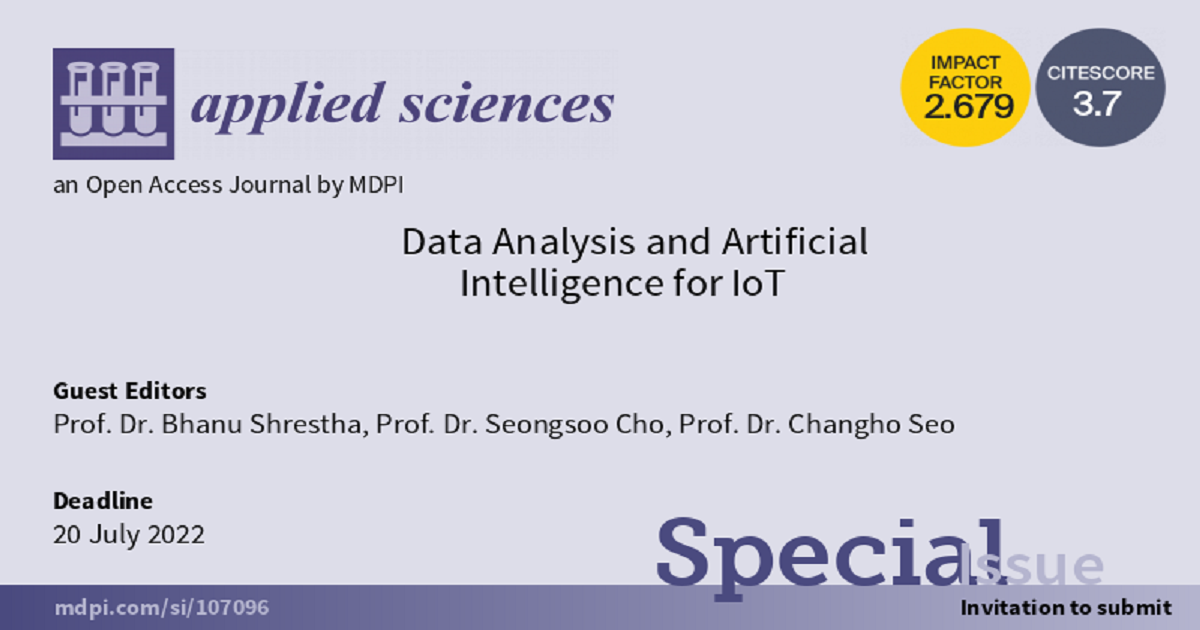Data Analysis and Artificial Intelligence for IoT
A special issue of Applied Sciences (ISSN 2076-3417). This special issue belongs to the section "Computing and Artificial Intelligence".
Deadline for manuscript submissions: closed (20 February 2023) | Viewed by 40039

Special Issue Editors
Interests: RFIC/MMIC/IPD device and system design; wireless communication; design and fab-rication of device and systems; RF biosensors; ICT convergence
Special Issues, Collections and Topics in MDPI journals
Interests: learning/machine learning; image processing; sensor networks; IoT
Special Issues, Collections and Topics in MDPI journals
Interests: cryptology; applied algebra; system security; network security
Special Issues, Collections and Topics in MDPI journals
Special Issue Information
Dear Colleagues,
Artificial intelligence is one of the most exciting fields of computing today. Over the past few decades, artificial intelligence has become a solid part of our daily life and has been successfully used to solve real-world problems.
IoT technology (IoT) develops hardware technologies day by day which can be connected by the devices. We can use artificial intelligence (AI) by reducing size, cost, and robustness. The AI-based IoT collects a huge amount of data from various sources. AI-based big data analytics are performed on these data to predict patterns. The globally accepted AI-based IoT is the driving force of innovative applications. The number of IoT devices will be increased by around 200 billion by the end of 2023.
This Special Issue will focus on the novel contributions that integrate IoT with ML/DL techniques and provide solutions to the big data paradigm.
Potential topics include but are not limited to the following:
- ML/DL techniques for circumventing big data in IoT applications;
- Hybrid and IoT-based networks;
- Data analysis and deep learning;
- Software engineering for IoT systems;
- Artificial intelligence systems in robotics and mechatronics;
- Innovative communications technologies and protocols for IoT applications;
- Healthcare data analytics using IoT and ML techniques;
- Data analysis application in communication.
Prof. Dr. Bhanu Shrestha
Prof. Dr. Seongsoo Cho
Prof. Dr. Changho Seo
Guest Editors
Manuscript Submission Information
Manuscripts should be submitted online at www.mdpi.com by registering and logging in to this website. Once you are registered, click here to go to the submission form. Manuscripts can be submitted until the deadline. All submissions that pass pre-check are peer-reviewed. Accepted papers will be published continuously in the journal (as soon as accepted) and will be listed together on the special issue website. Research articles, review articles as well as short communications are invited. For planned papers, a title and short abstract (about 100 words) can be sent to the Editorial Office for announcement on this website.
Submitted manuscripts should not have been published previously, nor be under consideration for publication elsewhere (except conference proceedings papers). All manuscripts are thoroughly refereed through a single-blind peer-review process. A guide for authors and other relevant information for submission of manuscripts is available on the Instructions for Authors page. Applied Sciences is an international peer-reviewed open access semimonthly journal published by MDPI.
Please visit the Instructions for Authors page before submitting a manuscript. The Article Processing Charge (APC) for publication in this open access journal is 2400 CHF (Swiss Francs). Submitted papers should be well formatted and use good English. Authors may use MDPI's English editing service prior to publication or during author revisions.
Benefits of Publishing in a Special Issue
- Ease of navigation: Grouping papers by topic helps scholars navigate broad scope journals more efficiently.
- Greater discoverability: Special Issues support the reach and impact of scientific research. Articles in Special Issues are more discoverable and cited more frequently.
- Expansion of research network: Special Issues facilitate connections among authors, fostering scientific collaborations.
- External promotion: Articles in Special Issues are often promoted through the journal's social media, increasing their visibility.
- e-Book format: Special Issues with more than 10 articles can be published as dedicated e-books, ensuring wide and rapid dissemination.
Further information on MDPI's Special Issue polices can be found here.







